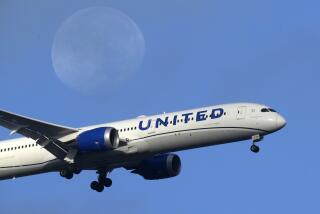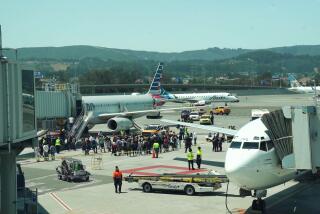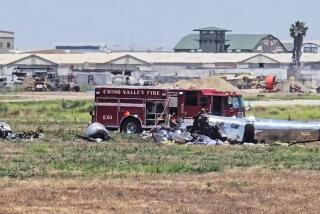Emergency chutes on Asiana flight deployed inside, worker says
The emergency chutes on an Asiana Airlines Boeing 777 deployed inside the aircraft and pinned two flight attendants to the floor when it crash-landed in San Francisco, an employee told the Associated Press.
Cabin manager Lee Yoon-hye told the news service that when the passengers and crew of Asiana Airlines Flight 214 were attempting to evacuate the plane, two emergency chutes inflated inside the aircraft, pinning two flight attendants to the floor.
Crew members had to hack at the emergency slides to deflate them, Lee told the Associated Press.
The episode was part of what has been described as a largely chaotic scene in the moments after Saturdayâs crash at San Francisco International Airport.
One crew member put an elementary-school-age boy on her back and slid down a chute onto the tarmac, the Associated Press reported. Others tried to put out a fire that engulfed the top of the cabin, Lee said.
Authorities are investigating if one of two girls killed in Saturdayâs incident was actually hit by an emergency vehicle responding to the crash.
Wang Linjia and Ye Mengyuan, 16-year-old girls from the eastern Chinese province of Zhejiang, died in the crash.
One of the two was found on the runway, and officials said she probably was ejected when the Boeing 777 crash-landed before bursting into flames.
The other, whose body was found closer to the wreckage, may have been run over by an emergency vehicle responding to the crash. Officials have not said which girl was which.
The girlsâ bodies were found a mile apart and were the dramatic crashâs sole fatalities, although 182 other people were taken to hospitals after the incident. At least two of those were paralyzed with spinal injuries, and eight remained in critical condition Sunday, hospital officials said.
The most serious, life-threatening injuries were spinal fractures that caused paralysis, abdominal injuries and head trauma, said San Francisco Generalâs Chief of Surgery, Dr. Margaret Knudson.
Others suffered sternum fractures, caused when the seats in front of them collapsed.
Most of the 53 patients treated at San Francisco General Hospital had been sitting near the back of the plane. Two of those in critical condition had âroad rashâ all over their bodies, Knudson said, suggesting they may have been dragged along the pavement.
Investigators are looking into whether pilot error contributed to the crash.
The targeted landing speed for the Boeing 777-200ER is 137 knots, and the South Korean jetliner was âsignificantlyâ below that, said Deborah A.P. Hersman, chairwoman of the National Transportation Safety Board.
Independent flight tracking data indicate the wide-bodyâs airspeed might have dipped to as low as 85 knots in the moments leading up to the crash.
Hersman said there was a call in the cockpit to increase speed seven seconds before the planeâs tail struck the sea wall that separates the airportâs runway from the bay.
According to onboard flight and voice recorders, the pilots received a warning four seconds before impact that the aircraft was approaching a stall -- a speed so low it can no longer generate enough lift to stay aloft.
At 1.5 seconds before impact, there was a call for the plane to abort the landing and circle around, Hersman said. By then it was too late, as the jetliner crashed and broke apart, killing two passengers and injuring dozens of others. The plane was carrying 307 people.
Asked whether pilot error may have been a factor, Hersman said: âEverything is on table right now. Nothing has been ruled out.â
ALSO:
Missing pit bull returns home to O.C. from Florida after 3 years
Asiana pilot sought second pass at landing moments before crash
More hot weather headed to Southern California, forecasters say
More to Read
Sign up for Essential California
The most important California stories and recommendations in your inbox every morning.
You may occasionally receive promotional content from the Los Angeles Times.










